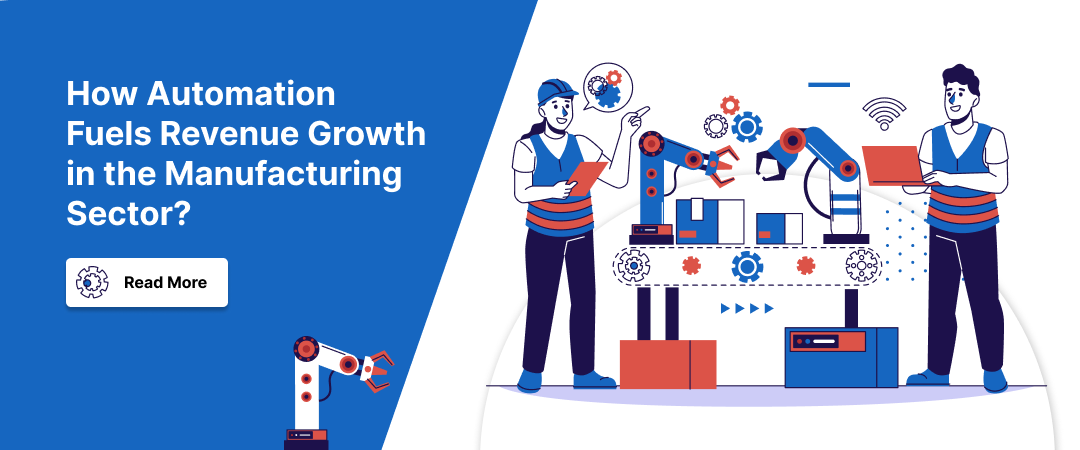
How Automation Fuels Revenue Growth in the Manufacturing Sector?

The trend towards automation is evolving day by day.
Now, manufacturing industries have joined the trend of automating their workflow processes for the increased safety and productivity of the modern factory. There are lots of scenarios that automation has become the need of hour for reshaping the manufacturing industry. In this blog, let’s explore the emerging trends of manufacturing industry and how it’s playing a major role in reshaping the operations of global trading.
From faster processes to supply chain innovations, automation in manufacturing looks much different than it has in past decades. Here’s what you should know.
Automate your Manufacturing Business | Reach us WhatsApp
1. Making Processes Faster and More Efficient
A recent report says that automation at a macroeconomic scale is expected to increase global manufacturing GDP between 0.8% and 1.4% per year. Even though the figures seem to be small, they play a significant role in the overall impact of economic growth.
Arriving with enhanced productivity, automation comes with the following advantages:
- Savings in Labor Cost
- Enhancement in Safety
- Improved Quality
- Boost in Overall efficiency
Recently, notable deprivation in production time and energy has occurred in resistance of human error and hefty procedures. With automated systems, efficiency can be incorporated amid better processes for fighting time-killing routine tasks. This in turn boosts productivity resulting in in increased revenues for manufacturers who opt for automation technology.
2. Collecting Data Through Digital Twinning
Perking up the manufacturing processes is achievable by opting the digital twinning trend which changes the manufacturing landscape. Digital twinning involves virtually Moulding the manufacturing process combining with the real-world process. With this technology, manufacturing companies can gather valuable data and models effortlessly for simulation and experimentation.
With a stat representing that 50% of large manufacturers set to utilize this technology, digital twinning clearly showcases the future of manufacturing sector. Besides, a report from McKinsey & Company states that, there is Up to 30% of improvements in product quality and product cycle time.
3. Increasing Safety Through Robotics
Robots are now taking on various roles to improve safety measures in different industries. These roles include:
Assembly Line:
Automated systems called co-bots are working alongside humans to enhance productivity and makes it easier to maintain on the assembly line.
Heavy Lifting:
Robots can efficiently move and transport heavy objects across a factory, reducing the risks associated with constant movement and handling of parts and packaging in the manufacturing industry.
By assigning hazardous tasks to robots, factories can provide a higher level of safety for their workers. This not only boosts productivity for manufacturers but also minimizes liability risks and overall costs.
4. Focusing on Logistics for Better Processes
Utilizing AI in manufacturing improves the efficiency of logistics at every stage, transforming the industry. The efficient functioning of AI in manufacturing is dependent on gathering and utilizing data to optimize logistics processes. This involves the use of sensors, digital twinning, analytics, and other tools to comprehensively comprehend and forecast the success of factory operations. As AI systems accumulate more data, they can enhance their understanding of manufacturing processes, notify technicians when maintenance is necessary, and develop more effective process models.
With all the implications for manufacturing improvement, AI is one trend of industrial robotics sure to last long into the future.
5. Betterment of Supply Chain Operations
By implementing supply chain automation, you can enhance the efficiency of your supply chain operations by digitalizing manual processes and enabling smooth data collection and analysis. This automation can handle time-consuming manual tasks such as document-processing and supply chain tracking, while also overseeing inventory levels to simplify workflows and reduce operational expenses. Real-time visibility into the supply chain allows for the identification of bottlenecks and inefficiencies, leading to the implementation of solutions that boost overall efficiency.
The utilization of optical character recognition (OCR) technology to automate the data entry process can expedite the processing of various documents including purchase orders, shipping bills, inventory lists, and invoices without the need for manual intervention.
The Changing Landscape of Manufacturing
As automation is emerging as trending technology, manufacturers look to reap maximum gains out of it. From enhancing processes to revamping efficiency, manufacturing automation plays a significant role in fueling revenue growth in the manufacturing sector. However, combining human touch with automation is crucial to create a perfect harmony for innovation and success.
With iSQUARE’s Manufacturing Automation Software, you can improve your manufacturing process effortlessly. Our customized manufacturing automation software helps you to efficiently manage sequence of tasks as well as , and improving product quality to boost revenue. Interested in automating your manufacturing operations? Schedule a call with our team of experts!
Automate your Manufacturing Business | Reach us WhatsApp














